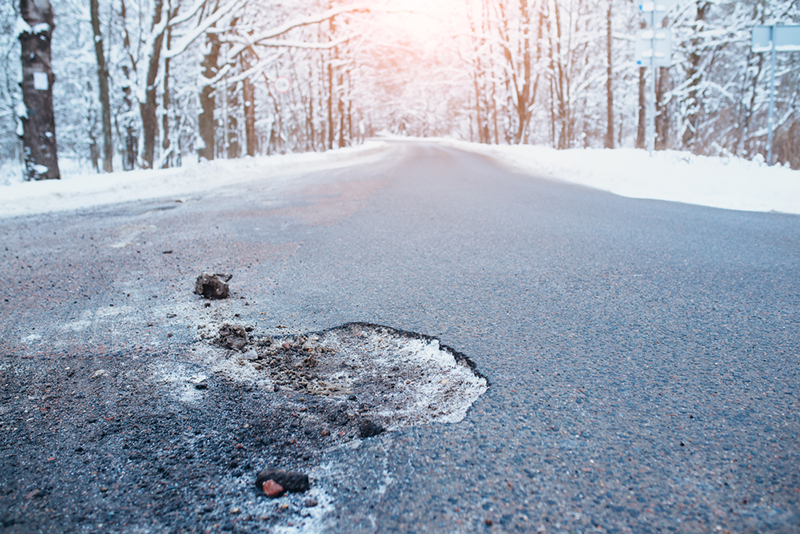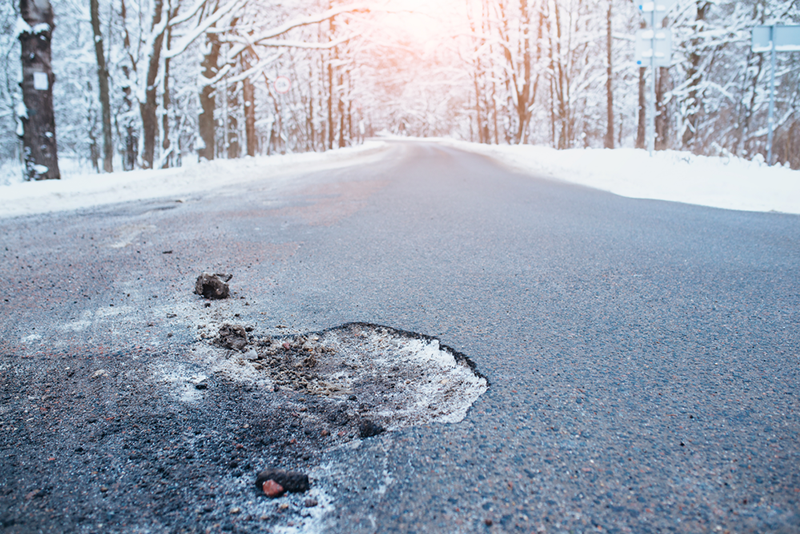Liquid Veins Give Ice Its Road-Wrecking Power
Make sure to leave an air gap when placing a sealed water bottle in the freezer. Fail to heed that warning and you will find out the hard way that water expands when it solidifies—and can break stuff in the process. Such expansion might seem to explain other instances of ice-induced destruction on winter-ravaged roads and buildings. But, in fact, ice-generated potholes and cracks result from an ice-growth process, the determinants of which are poorly understood. Now Robert Style of the Swiss Federal Institute of Technology (ETH) in Zurich and colleagues reveal one of those factors: the presence of liquid channels within polycrystalline ice [1]. The finding could help scientists develop accurate models of freezing-induced infrastructure damage and aid engineers in developing strategies to stop this multibillion-dollar problem.
Most liquids contract when they solidify. Water is a rare exception. It expands by about 9% when it freezes. But it turns out that this expansion mechanism plays next to no role in most freezing-induced damage scenarios, such as when ice generates cracks in the sides of brick buildings or potholes in the surfaces of asphalted roads. Thinking such damage comes from water expansion is a long-known misconception, Style says.
In experiments with soil, researchers have shown that benzene, a liquid that shrinks when it freezes, produces identical damage to freezing water, indicating the phase-transition volume change is not the destruction culprit. Instead, the main factor appears to be the ability of freezing liquids to “suck” more liquid into the freezing zone.
Picture a water-filled straw lying horizontally on a flat surface and subjected to freezing temperatures on one end. As water in the frosty end of the straw turns to ice, a negative pressure develops around the newly crystalized material. This negative pressure induces a “sucking” action that moves balmy water to the wintry zone. That sucked water then freezes, and the process repeats until the swelling ice cylinder becomes too wide for the straw and the straw splits apart. In the everyday world, “this [process] can go on for a very long time, damaging materials and structures,” says Sylvain Deville, a materials scientist at the University of Lyon 1, France. Deville was not involved in the new study but did advise the researchers during the building of their experimental setup.
Scientists have measured the rate of this so-called cryosuction in soil and asphalt, but the opaqueness of these materials rendered it impossible to watch the process in action. “Without being able to directly see what was happening, we could only make assumptions about what was going on,” Style says.
Style and his colleagues solve the opaqueness problem by fabricating a simple porous material from two transparent glass slides. The glass slides were separated by spacers and the interior patterned with a light-curable glue to make a single pore a few millimeters long and a few millimeters wide. They coated the interior of the bottom side of the pore with a thin layer of silicone, a soft material, which they decorated with fluorescent particles. They then filled the pore with pure water. They chilled one end of the pore while heating the other as per the hypothetical straw described previously.
The team tracked the shape evolution of the silicone layer as a function of time using a confocal microscope—a three-dimensional imaging tool that uses fluorescent markers to image the structures inside transparent materials. Initially, the silicone remained undisturbed. But once the water in the cold end of the pore had all turned to ice—in this case, one long ice crystal—the team observed the silicone start to deform. This deformation continued as the ice crystal grew in width and pushed down harder on the soft silicone layer.
Zooming in on the silicone–ice interface, Style and his colleagues observed that between the hard ice and the soft silicone there existed a few-nanometer-thick liquid film, the source of the liquid water needed for the ice expansion. “Ice doesn’t like to be in contact with most surfaces,” Style says. “So between ice and most surfaces there is a gap along which water can flow.”
On its own, the gap seen in the single-crystal experiments was too narrow to provide enough water to grow ice at the rate measured in previous experiments with soil or asphalt. “The process was incredibly slow,” Style says. “It took five hours for the ice to thicken by a couple of micrometers.” That rate however drastically increased when the team grew polycrystalline ice, which the confocal images revealed contained many additional paths for liquid water to infiltrate the frozen system. Between each ice crystal existed a narrow vein, which, like the water-filled gap above the silicone, could transport water. “Suddenly, there were all these extra channels that could suck up water, so the ice could grow much more quickly,” Style says.
This study presents the results of a “clever” and “carefully crafted” series of experiments that show a clear link between the polycrystallinity of ice and the rate of cryosuction, Deville says. He adds that most ice contains multiple crystals, and this study shows that if scientists want to understand the microscopic mechanisms behind how frozen water behaves, they need to probe more realistic systems.
For Daniel Draebing, a geomorphologist at Utrecht University, Netherlands, who studies ice damage in rock formations, the findings have wider implications. Style and his colleagues show that “we have to rethink our understanding of weathering by ice pressure or stresses,” he says. “The existence of [channels] in polycrystalline ice and the associated amplification of ice stresses makes such weathering much more efficient than we assumed.”
The final efficiency-increase estimates will likely depend on additional, currently unexplored factors, such as the presence of solutes in the water. Still, the importance of polycrystallinity in ice-induced damage could influence, for example, the design of materials used in roads, Style says. In addition, officials in cities that experience flash-freezing events may need to be more vigilant against ice damage, as faster forming ice typically contains more crystals than slower forming ice. So, when winter arrives unexpectedly, keep your eyes out for new potholes.
–Katherine Wright
Katherine Wright is the Deputy Editor of Physics Magazine.
References
- D. Gerber et al., “Polycrystallinity enhances stress buildup around ice,” Phys. Rev. Lett. 131, 208201 (2023).





